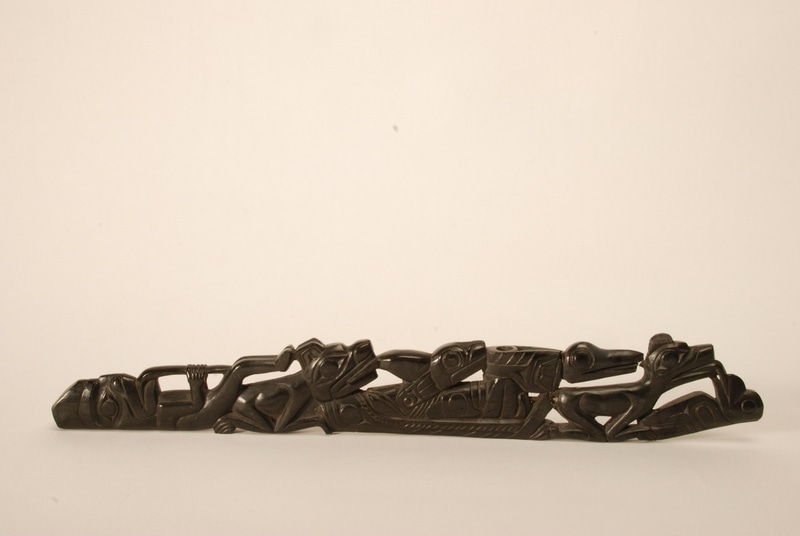Pipe Item Number: Z 34992 from the MAA: University of Cambridge


Description
A panel pipe bearing numerous interconnected creatures. The creature which forms the mouthpiece is possibly humanoid with a long tongue extending between its knees. The second creature is possibly a bear which is biting the tail of a seal-like creature. The bowl of the pipe is formed from the body of a bird which is touching the neck of another bear-like creature which in turn is joining tongues with another bird. There is a rudimentary creature in the centre of the pole which, together with the last bird, has not been finished to the same extent as the other creatures.The panel pipe has been broken and repaired but is now in a very delicate condition.; Fair
Context
The original European tribal names and, where possible, current tribal names have both been given in separate GLT fields.; The style and subject matter of this object conforms to those of the First Period of argillite carving, 1800-1835, the so-called period of Haida non-sense . The carvings are typically ceremonial pipes and Panel pipes, depicting ambiguous creatures that on first glance appear to resemble crest animals but on closer examination are revealed to be non-sensical combinations of characteristics. The reason for this subversion of crest designs is possibly because at this time the giving away of crest bearing objects was antithetical to Haida social and cultural beliefs. This was because attendant on the ownership of a crest was a variety of resources and privileges which could not be jeopardised by a counter claim to access communicated by ownership of a crest bearing object. To own a crest bearing object communicated a legitimate claim to the attendant resources, therefore to give away such objects was not sanctioned (G.Crowther). (The time periods of argillite carvingare derived from Carol Sheehan' s Pipes That Won' t Smoke; Coal That Won' t Burn; Haida Sculpture in Argillite, 1981, Glenbow Museum: Calgary, and Peter Macnair and Alan Hoover' s The Magic Leaves, 1984, British Columbian Provincial Museum: Victoria.)
Item History
- Made in Queen Charlotte Islands (Haida Gwaii), British Columbia, Canada
Who
- Culture
- Haida
Where
- Holding Institution
- MAA: University of Cambridge
- Made in
- Queen Charlotte Islands (Haida Gwaii), British Columbia, Canada
Other
- Keyword
- Art; Tourist Objects; Narcotics and Intoxicants